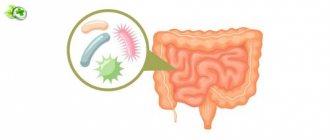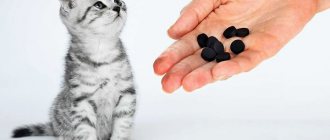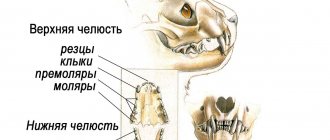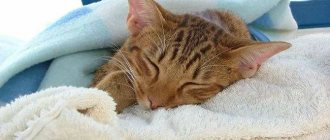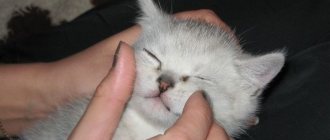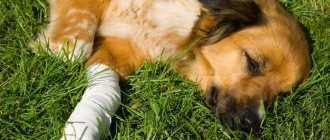Gastric lavage is a medical treatment procedure, the technique of which should be mastered by all people with pets . In case of acute poisoning, it can save the animal’s life. In this article, we looked at how to rinse a cat’s stomach at home, what are the indications and contraindications for this procedure.
The main indications for cleansing the stomach of a cat
Gastric lavage for cats is most often performed in emergency situations. Cats are less susceptible to poisoning than dogs . They are more picky about food, rarely eat rotten and spoiled food, but still acute intoxications and poisonings occur quite often among them, you need to be prepared for their development. Below are the main indications for emergency gastric lavage at home:
- Food poisoning can occur as a result of animals consuming expired food or meat. Dry food practically does not change its smell and taste after the expiration date, the animal can eat it. Check the manufacturing date of all food you give your pet.
- Poisoning from household detergents. Some cats are attracted to the smells of bleach solutions and various chemicals.
- Drug intoxication can develop if medications are left within the reach of the animal. Cats may like the smells of fragrances that are added to medications, for example, menthol, lemon balm, valerian.
- The development of adverse reactions, allergies, after the use of anti-worm medications by an animal. These medications may be toxic to your pet . The rules for their administration and dosage should be discussed with your veterinarian.
- Cat eating rodents poisoned with rat poison.
Please note that if the animal does not live in an apartment, but in the private sector, it can be poisoned by various poisons. Such intoxications are the most severe and often lead to the death of the pet.
Main symptoms of food poisoning in cats
Symptoms of food poisoning in cats develop during the first 4-6 hours after eating low-quality, spoiled food. The rate at which they increase depends on the type of toxin and the amount eaten. In kittens, symptoms appear more quickly.
Signs of food poisoning in cats:
- repeated vomiting of food, bile, mucus or stomach acid. Animals that are vomiting constantly smack and lick their lips;
- repeated and profuse diarrhea. The stool may be foamy, streaked with blood and mucus, and have a foul odor;
- reduced activity of the pet. The cat constantly lies down, does not walk around the house, does not play;
- anorexia – complete lack of appetite;
- hyperthermia. With food intoxication, the temperature can rise to 40 degrees;
- breathing disorder. It becomes frequent, more superficial, similar to shortness of breath;
- tachycardia is a rapid heartbeat, it develops as a result of dehydration and severe intoxication syndrome. When body temperature rises by 1 degree, the pulse accelerates by 10-15 beats/min;
- In case of severe intoxication, cramps in the skeletal muscles and impaired consciousness of the pet are possible.
Due to repeated vomiting and diarrhea, severe dehydration develops , in which visible mucous membranes become dry and the eyeballs become sunken.
In what cases is it forbidden to rinse the stomach on your own?
There are situations in which it is strictly prohibited to rinse an animal’s stomach. First aid in such cases should be provided by a veterinarian as soon as possible after the first symptoms of the pathology appear. Contraindications to self-gastric lavage include:
- Gastrointestinal bleeding, which can develop as a result of cat poisoning with rat poison or the use of detergents and various chemicals. This condition is characterized by vomiting and black diarrhea . If there is internal bleeding, the animal should not have its stomach washed or given any medications or drinks. All this can increase blood loss.
- Poisoning with acids or alkalis. With this pathology, stomach cleansing is carried out through a tube in a veterinary clinic.
- Impaired consciousness of the pet. In this case, self -washing can lead to choking on vomit .
Video “How to wash the corners of a cat’s eyes”
Despite the fact that gastric lavage at the first signs of poisoning is a very important procedure for providing first aid to an injured animal, there are still situations when doing this is strictly prohibited.
The risk group includes the following contraindications:
- Gastrointestinal bleeding caused by exposure to strong chemicals, detergents, or rat poison. You can determine the serious condition of your pet by vomiting and black feces. In this case, under no circumstances should you give the animal any medications or even plain water - all these measures can provoke even greater blood loss and significantly worsen the already deplorable situation of the animal.
- Poisoning with alkalis or acids. With this type of poisoning, ordinary gastric lavage will not help, and it will be necessary to undergo special cleansing using a probe in a veterinary clinic.
- State of fainting. If a disturbance in your pet’s consciousness has been noticed, do not force water into it and induce vomiting, otherwise it may choke on the vomit.
In a state of fainting, you should not force water into your cat!
In order, if possible, to avoid such a development of events, it is necessary to ensure that there are no hazardous substances within the cat’s reach, including ordinary detergents and medications. It is important to monitor the quality of the food he eats, as well as its expiration dates.
We suggest you read: Why does a cat lose weight and not gain weight?
There are several reasons why your pet needs a gastric lavage. The most common of them is poisoning from poor-quality food, or the inability of the stomach to digest it. Another reason for intoxication is that when cats wash their fur, they lick it and thereby “swallow it.”
Also, quite often in cats the gag reflex is triggered on its own, but this does not always happen and in such cases the animal needs to come to the rescue and rinse the stomach with a special solution that you need to prepare yourself.
A cat that ingests an indigestible object unintentionally or on purpose is at risk of intestinal blockage or volvulus, partial or complete obstruction, recurrent vomiting, or toxicity. In such a case, lavage of the cat’s stomach is a necessary measure if more loyal means do not produce results.
Intoxication with poisons, no matter whether they were swallowed or entered the body through contact, causes rapid damage to the nervous system. Help is provided immediately - the animal needs to rinse the stomach, induce vomiting, provide plenty of fluids and provide professional assistance.
With partial blockage of the intestines, constipation, vomiting or urge, loss of appetite and primary symptoms are observed. Blockage of the intestines by hair is perhaps the most common case that the owner of a long-haired pet may encounter. If the animal appears active, feed it wool-dissolving paste.
In an advanced situation, you will need to cleanse the cat's stomach of hair by rinsing it. To carry out the procedure at home you will need:
- A syringe, a syringe without a needle or a tube, part of the IV system will do. After cutting the tube, melt it down to avoid injury.
- Clean water in which absorbent or special paste can be dissolved.
Before starting the procedure, you need to protect yourself and immobilize the cat:
- Wear long sleeves.
- Tie the animal's paws and wrap it tightly in a towel.
- Place the tube under your tongue and start pouring in the liquid.
- The maximum allowable amount of liquid for an adult cat is no more than 500 ml.
- Pour in half the liquid and try to make the cat vomit. If there is no urge, repeat the procedure.
- Make sure that when vomiting, all the mass comes out freely. Once the fur is out of the stomach, carefully untie the cat and leave it alone.
- 20–40 minutes after the procedure, the pet needs to drink an enveloping agent, milk or egg white.
Important! If you observe signs of severe intoxication or vomiting of feces, immediately take the animal to the veterinarian. Symptoms indicate intestinal volvulus, which is fatal if delayed.
You need to understand that poisoning with stale food and poisons are completely different situations that require appropriate help. When food poisoning occurs in a cat:
- Weakness.
- and diarrhea.
- Slight decrease in body temperature.
- Kosha refuses to eat, but not to drink.
In case of severe poisoning, the above symptoms are more active, the animal’s mucous membranes turn pale, saliva flows heavily, and loss of consciousness may occur. If the animal is conscious, gastric lavage with potassium permanganate is required.
Be careful! The potassium permanganate solution should be barely pink. After preparing the rinsing liquid, partially drain it into a clean container. It is important to prevent manganese crystals from entering the stomach.
The washing solution is prepared from absorbent (4 tablets of coal), table salt (1/2 teaspoon) and soda (2-3 g), dissolve the resulting powder in 500 ml of warm water. Washing is done 3-4 times.
Monitor your body temperature carefully and if it drops, call your veterinarian.
If an animal at home loses consciousness, the chances of quality help are reduced to zero. You simply drown the animal by pouring the solution down its throat. If you have a steady hand, you can try inserting the tube into the cat's stomach. The measure is relevant only for the introduction of fast-acting absorbents.
- Lay the animal on its side and secure it.
- Arm yourself with a flashlight, coat the edge of the tube with Vaseline and begin inserting the “probe” into the esophagus.
- Take your time and start over if the tube hits something.
- Be sure to check where the tube got into by blowing into it. If the tube is in the stomach, the abdominal cavity will swell.
- Once the tube is in the stomach, administer absorbents. This will give you a little time and you will have time to take the animal to the doctor.
Important! Filling the stomach with liquid can cause the pyloric valve to open, after which toxic substances enter the intestines.
If petroleum products, alkali or acid are ingested, forced vomiting or gastric lavage is contraindicated for the animal. To relieve primary intoxication, the animal must:
- Drink a 3% hydrogen peroxide solution. To prepare the solution, use hydrogen peroxide diluted with saline solution or clean water. The resulting substance is given to the cat three times in an amount of 5–15 ml, with a break of 10–15 minutes.
- In case of acute intoxication, drink root emetic syrup at a dosage of 1 ml per 1 kilogram. As a complication, root emetic has a toxic effect on the heart muscle, making the measure risky.
- A solution of hydrogen peroxide provokes vomiting and destroys the toxic substance, which must be removed from the body using sorbents - activated carbon, Atoxil, Enterosgel.
- The absorbent is drunk twice with a break of 20–30 minutes, after which the stomach is washed.
If the swallowed object is small and does not have sharp edges, then help at home will consist of soldering the dog with various mineral oils (vaseline, for example), which will facilitate the rapid removal of the foreign body naturally through the rectum.
Due to the fact that the dog has a widened entrance to the pharynx, it can swallow anything. If an object gets stuck in the area of the pharynx and esophagus, the animal will begin to choke; if in the stomach and intestines, then signs of blockage in these parts of the gastrointestinal tract will appear after some time (from several hours to several days).
- The animal is unconscious.
- The poisoning was such substances as kerosene, turpentine, barbiturates and opiates, gasoline, acids and alkalis (household chemicals).
- The owner is not sure he can handle it.
It is very good if pet owners have a veterinarian on duty, who can provide conversational advice and suggest the course of action.
As a rule, therapeutic gastric lavage is performed on an animal in case of severe intoxication, that is, poisoning. However, sometimes it is necessary to lavage the cat’s stomach when the pet has “swallowed” its own fur. Despite the fact that in most cases cats can induce vomiting on their own, sometimes they cannot do it without the help of the owner. We will tell you how to properly perform the gastric lavage procedure on a cat in our publication today.
To begin, prepare a small amount of liquid (about two glasses), since too much water entering the stomach can cause the pyloric opening to open, allowing the contents of the stomach to pass freely into the intestines. Methodical gastric lavage is carried out in two or three stages, with the last two rinses performed with the maximum amount of water, due to which all folds of the mucous membrane are straightened.
If the cat has simply swallowed fur, then one or two rinses with a small amount of water are enough. When the fur comes out with vomit, the cat can be left alone. However, if gastric lavage is required due to poisoning of a pet, then you should act promptly. Moreover, even if several hours have passed since the cat was poisoned, there is no need to refuse gastric lavage, since the poison may remain in the body and your animal will suffer.
We suggest you read: Do chickens have a runny nose? Advice from a veterinarian
The main symptoms of cat poisoning are: weakness, trembling, profuse drooling, pain in the abdomen, convulsive twitching, shallow rapid breathing. In this case, the symptoms appear suddenly and grow very quickly.
To lavage your cat's stomach, you can use a rubber syringe and try to forcefully pour in water or a special solution. This must be done very carefully so that the cat does not choke.
Method for cleansing the stomach at home
It is not difficult to rinse a cat’s stomach correctly. When performing this procedure, there is no need to feel sorry for her and stop the manipulation when you see that she doesn’t like it .
You must understand that you are cleaning the gastric cavity for the benefit of the animal, and at the moment its life depends on you. To lavage the stomach at home, you need a 20 ml syringe, plain water at room temperature and salt . Pour 40-60 ml of water into the cat's mouth with a syringe (without a needle), then apply a little salt to the root of her tongue with your finger. Salt will cause vomiting and the stomach will be cleared of toxins. This procedure can be repeated several times.
Remember that gastric lavage for animals is prohibited using a solution of potassium permanganate. This substance can cause burns to the mucous membranes of the esophagus and cause severe intoxication.
Contraindications
A cat that ingests an indigestible object unintentionally or on purpose is at risk of intestinal blockage or volvulus, partial or complete obstruction, recurrent vomiting, or toxicity.
In such a case, lavage of the cat’s stomach is a necessary measure if more loyal means do not produce results. Intoxication with poisons, no matter whether they were swallowed or entered the body through contact, causes rapid damage to the nervous system. Help is provided immediately - the animal needs to rinse the stomach, induce vomiting, provide plenty of fluids and provide professional assistance.
Gastric lavage is aimed at cleansing the cavity of not only the stomach, but also part of the intestines in order to reduce the harmful effects of toxic substances.
Toxins, poisons, bacteria enter the digestive tract along with food, in case of an overdose of medications (for example, deworming agent - Pirantel), accidental consumption of poisonous plants, fruits, etc. The procedure is carried out both at home and in a hospital. In this way, it is possible to improve the patient’s general condition, relieve abdominal pain, and avoid serious consequences.
In case of acute food poisoning, gastric lavage is carried out in two main ways:
- probeless;
- using a special tube (probe).
Each method must be performed in a certain order and strictly according to indications.
The cleansing procedure is indicated for the following types of poisoning:
- Food - observed when consuming stale foods, especially fermented milk, fish, meat, as well as inedible or conditionally edible mushrooms.
- Medication - as a rule, it is carried out with suicidal intent, but accidental use of medications by children or the elderly is possible.
- Alcoholic - intoxication as a result of drinking a large amount of alcoholic beverages.
- Non-food - caused by the ingestion of chemical impurities and toxic compounds into the body. For example, household chemicals, vinegar and other acids, technical liquids, iodine, alkalis with a high concentration of active substances.
It should be remembered that for gastric lavage in case of alkaloid poisoning, completely different solutions are used than in case of intoxication as a result of the use of strong alkalis or other chemicals. The most common alkaloids include:
- caffeine;
- morphine;
- quinine;
- cocaine and others.
Each toxin has a specific mechanism of action on the mucous membranes and on the body as a whole. Taking this into account, a solution is selected that neutralizes the harmful effects.
It is forbidden to rinse the stomach at home if the victim exhibits the following clinical signs:
- severe form of burns of the esophagus, larynx - especially in case of poisoning with acids and alkalis;
- opening of bleeding from the gastrointestinal tract;
- cerebral circulatory disorders;
- disruptions in the functioning of the cardiovascular system (heart rhythm disturbances, myocardial infarction, etc.);
- pathological narrowing of the lumen of the esophagus.
It goes without saying that tubeless gastric lavage is contraindicated in case of poisoning when the patient is unconscious. In this case, the procedure is allowed to be performed in a hospital.
In case of poisoning with cauterizing poisons or concentrated acids, gastric lavage is not recommended, since the reverse movement of vomit can provoke the development of bleeding in places of severe damage to the mucous membrane.
Sit the patient upright or lay him on his side. If rinsing is done at home, it is best to do it in the bathroom. Measure blood pressure using a tonometer and calculate heart rate per minute.
Be sure to remove braces and removable dentures to avoid accidentally getting them into the esophagus or respiratory tract. Next, prepare a solution for washing. First place the necessary utensils (a jug of liquid, a glass, a basin or a bucket for rinsing water).
Prepare a towel or napkins.
You can do exclusively probeless rinsing yourself. In a hospital setting, as a rule, a special tube is used - a probe. Preparation is carried out by medical staff. Tube gastric lavage in case of acute oral poisoning requires special skills and cannot be used if there is a possibility of perforation of the walls of the digestive tract.
The liquid to cleanse the stomach should have a temperature of approximately 20 - 25 degrees. Hot water can cause vasodilation and, therefore, stimulate the absorption ability of the mucous membrane. Cold weather can cause smooth muscle spasms. At home, as a rule, a cleansing drink is made corresponding to normal body temperature.
The easiest to prepare is a saline solution. For 2 - 2.5 liters of water you need to add 1 tbsp. l. salt (sodium chloride). A soda solution is prepared using a similar recipe, but it cannot be used in cases of damage to the gastrointestinal tract by acids.
As a result of the chemical reaction, a considerable amount of carbon dioxide is formed. This can lead to bloating and rupture of the affected walls of the digestive tract.
Nitrofural (furatsilin) is active against streptococcus, E. coli, Candida fungi, salmonella, and other microorganisms. 1 – 2 tablets are crushed and dissolved in 1 liter of water.
Potassium permanganate: 3-4 crystals of potassium permanganate must be completely dissolved in 1 liter of water. Used to reduce harm from drinking alcohol and its derivatives. In case of alkaloid poisoning, repeated gastric lavage with a weak solution of potassium permanganate is indicated.
In case of alkali poisoning, gastric lavage is carried out using a 1% solution of acetic or citric acid. The probe method is preferred.
Algorithm for carrying out cleansing activities in a clinical setting:
- Sit the victim upright or lay him on his side.
- Raise his chin, support the child’s head with his hands.
- Put a special apron on the patient and lower the hem into a container intended for collecting vomit.
- Treat the end of the probe inserted into the esophagus with Vaseline and place it at the base of the tongue.
- Then advance it yourself, or ask the patient to perform a swallowing movement. When inserting the tube, you must monitor your nasal breathing.
- Tilt the victim's head forward slightly.
- Check the location of the probe in the stomach cavity using a Janet syringe and listening through a phonendoscope (characteristic sounds of air bubbles should appear);
- Connect the funnel and fill it with liquid for rinsing (the first portion at the rate of 15 ml per kg of body is for children).
- Raise the funnel slowly, creating pressure to introduce the liquid inside.
- Lower the system below the level of the stomach to extract its contents.
- Pour out a portion of the washing water for bacteriological analysis. The remaining amount is placed in a previously prepared container.
- Repeat the process until completely clean. If necessary, introduce a sorbent into the gastric cavity.
We invite you to familiarize yourself with: Exotic shorthair cat character habit
The final stage:
- Disconnect the funnel.
- Remove the probe through a cloth soaked in antiseptic.
- Dip used system elements into a disinfectant solution. Dispose of the napkin in a special container for waste class B. Disinfect the rinsing water.
- Invite the patient to rinse the mouth. Wipe your face. Remove the apron. Take the patient to the room and organize monitoring of his condition.
- The manipulation nurse takes off her gloves and treats her hands with an antiseptic.
- An entry is made on the appointment sheet.
It is important to strictly follow all the rules for performing the manipulation in order to avoid the development of complications.
"Restaurant" method
The essence of the method is as follows:
- drink a sufficient amount of liquid yourself (the proportions for preparing the solution are 1 teaspoon of soda or salt per 1 liter of water);
- use your index or middle finger to press on the root of the tongue, provoke a gag reflex;
- bend over a basin, washbasin, toilet;
- let the liquid come out.
How to do gastric lavage using a thick probe in case of poisoning:
- A rubber tube 80 - 120 cm long, 10 - 13 mm in diameter is connected to a funnel or mug with a cut end.
- Treat the round end with Vaseline. Enter through the esophagus into the stomach cavity.
- Fill the container with the first portion of the solution (soda, salt, manganese). Lift it up so the liquid goes inside.
- Lower the bowl and drain the contents.
- Repeat until the wash water is completely clear.
The total amount of fluid administered is 5–10 liters for an adult.
The method has contraindications:
- peptic ulcer;
- neoplasms of the digestive system;
- bleeding;
- heart failure;
- bronchial asthma.
A peculiarity of gastric lavage in case of poisoning with cauterizing poisons is that it is important to carry out the procedure as soon as possible after the substance is ingested. Optimally - within the first 6 - 8 hours. Further, the effectiveness and safety of the method decreases.
Cauterizing poisons include:
- oxidizing agents (potassium permanganate, hydrogen peroxide, methyl alcohol, ammonia);
- alkalis;
- acids of organic, mineral origin (oxalic, acetic, hydrochloric).
Probe lavage can be carried out after the administration of painkillers, narcotic analgesics (for example, morphine). Areas of the oral cavity burned with potassium permanganate are treated with 3 percent ascorbic acid. After the procedure, it is recommended to swallow ice cubes and apply cold water to the stomach.
The use of a probe is indicated for acute food poisoning in dogs. The principle and procedure of manipulation are similar, with a difference in the amount of liquid administered, which is determined depending on the weight and size of the pet.
It is important to know a clear algorithm for gastric lavage in case of poisoning with oral tablets that have a narcotic effect. Step-by-step instructions will help stabilize your condition even if you are intoxicated. You are allowed to perform the manipulation yourself without a probe.
Possible complications that may develop if recommendations are not followed correctly or in a timely manner include:
- obstruction of the respiratory tract by vomit, suffocation;
- obstruction of the trachea, bronchi as a result of penetration of the probe;
- venous bleeding from the esophagus or stomach due to perforation of the walls.
What else can you do to help your pet in case of acute poisoning?
When the first symptoms of poisoning develop, the cat’s stomach should be rinsed. But this procedure alone is not enough when providing first aid.
After cleansing the stomach, you should:
- Do a cleansing enema. To carry it out you will need baby pears with a volume of 50 ml. The enema should be done with plain water at room temperature . It should be carried out 2-3 times until clean intestinal rinsing water appears.
- Give the animal sorbents. You can use simple activated carbon. Grind half a tablet of coal and dilute it in 5 ml of water. Inject the resulting solution into the cat's mouth through a syringe without a needle.
- Give your pet plain water. Every 15 minutes, inject him with 5 ml of liquid through a syringe.
After providing first aid, you should immediately take the cat to a veterinary hospital.
There the doctor will conduct an examination and examination and prescribe treatment. For some time, you will need to bring the cat to the clinic for IVs and examination, feed it according to the diet prescribed by the doctor, and give it medications. To clarify the diagnosis and identify complications, it may be necessary to conduct a general and biochemical blood test, bacteriological culture of stool, and ultrasound examination of internal organs.
Gastric lavage is an important treatment procedure for cat poisoning . All people who have pets at home should know the rules for conducting it. Stomach cleansing is carried out using a 20 ml syringe and plain water. It is prohibited to use potassium permanganate to treat animals. In addition to cleansing the stomach, if acute poisoning develops, you should do a cleansing enema and give your pet sorbents and drink. After first aid is provided, the cat should be taken to a veterinarian for examination. Self-medication is very dangerous.
How to help a cat with poisoning if gastric lavage is contraindicated
If petroleum products, alkali or acid are ingested, forced vomiting or gastric lavage is contraindicated for the animal. To relieve primary intoxication, the animal must:
- Drink a 3% hydrogen peroxide solution. To prepare the solution, use hydrogen peroxide diluted with saline solution or clean water. The resulting substance is given to the cat three times in an amount of 5–15 ml, with a break of 10–15 minutes.
- In case of acute intoxication, drink root emetic syrup at a dosage of 1 ml per 1 kilogram. As a complication, root emetic has a toxic effect on the heart muscle, making the measure risky.
- A solution of hydrogen peroxide provokes vomiting and destroys the toxic substance, which must be removed from the body using sorbents - activated carbon, Atoxil, Enterosgel.
- The absorbent is drunk twice with a break of 20–30 minutes, after which the stomach is washed.
Source of the article: https://vashipitomcy.ru/publ/zdorove/lechenie_i_profilaktika/kak_promyt_zheludok_koshke_pokazanija_i_porjadok_dejstvij/16-1-0-1075
